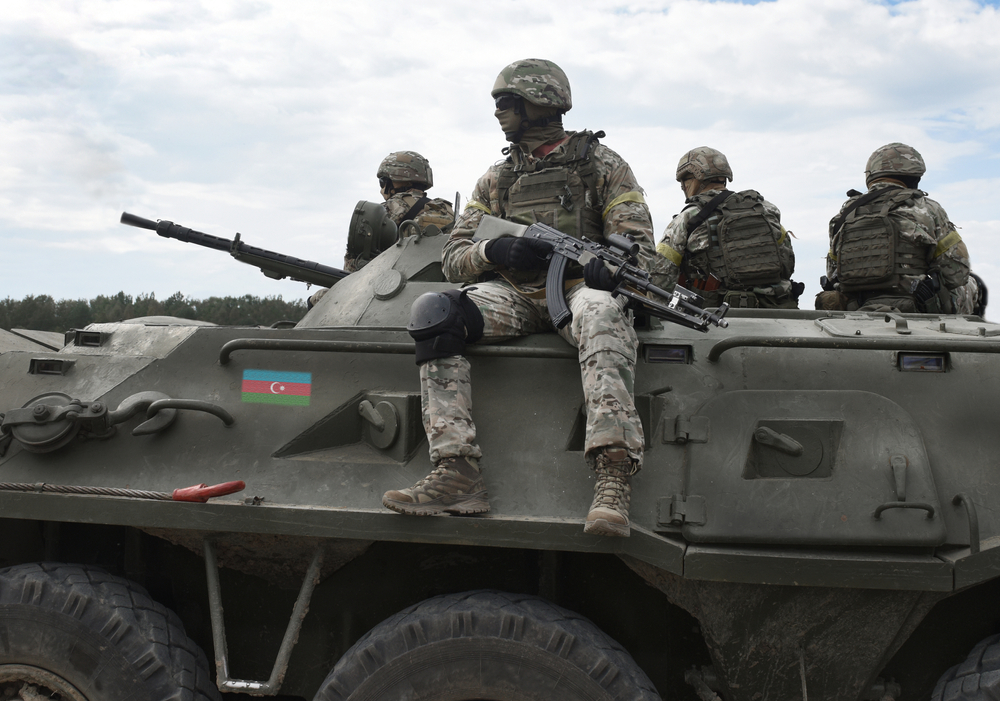Armenia and Azerbaijan agreed to a ceasefire along the Line of Contact in the occupied Nagorno-Karabakh region of Azerbaijan starting on Saturday for humanitarian purposes. The breakthrough came after 11 hours of talks between the Russian, Armenian, and Azerbaijani foreign ministers in Moscow on Friday and early Saturday.
The Foreign Ministry of Azerbaijan reported that the ceasefire starts at 12:00 pm Saturday. The main purpose of the armistice is to exchange of hostages and bodies of those killed in the clashes through the mediation of the International Committee of the Red Cross.
"Concrete parameters of the ceasefire will be agreed additionally," reads the statement published to the ministry's website, adding that the format of the talks will not be changed.
"The Republic of Azerbaijan and the Republic of Armenia, through the mediation of the OSCE Minsk Group Co-Chairs, kick off substantive negotiations to achieve a peaceful settlement to the conflict on the basis of the basic settlement principles as soon as possible."
The current format of talks supposes negotiations between Armenia and Azerbaijan through the mediation of the OSCE Minsk Group Co-Chairs, while any third party to talks is unequivocally excepted.
Hours before the Moscow meeting, Azerbaijan's President Ilham Aliyev announced in a televised address to the nation that the national army has liberated more lands from Armenia's occupation. The army has regained control over the Hadrut settlement in the Khojavand district and eight villages in Tartar, Fuzuli, and Jabrayil districts, according to the president.
Hostilities along the Line of Contact in the occupied territories of Azerbaijan renewed with Armenia's shelling the military and civilian settlements in Azerbaijan on September 27. The offensive prompted immediate counter-attack measures by the Azerbaijani forces. Clashes have flared up in the wake of the deployment of heavy artillery by both sides on the battlefield. Azerbaijani troops have so far liberated the city of Jabrayil, the settlements of Hadrut and Sugovushan, and more than thirty villages in the districts of Jabrayil, Fuzuli, Khojavand and Tartar from Armenia’s occupation.
Armenian authorities admitted to 405 servicemen deaths until the ceasefire. However, the Defense Ministry of Azerbaijan said 2,300 servicemen of Armenia have been killed and wounded. No number has so far been revealed for the military casualties of Azerbaijan. However, 31 civilians have lost their lives as a result of Armenia's shelling the densely populated residential areas in multiple cities of Azerbaijan.
Armenia and Azerbaijan have been locked in a decades-old conflict over the Nagorno-Karabakh region, which is the internationally recognized territory of Azerbaijan but occupied by Armenia. Following the Soviet Union’s dissolution in 1991, Armenia launched a military campaign against Azerbaijan that lasted until a ceasefire deal was reached in 1994. Armenia occupied 20 percent of Azerbaijan’s internationally recognized territories including the Nagorno-Karabakh region and seven surrounding districts. One million ethnic Azerbaijanis were forcibly displaced from these areas and 30,000 were killed.
Armenia rejects to fulfill four UN Security Council resolutions that demand the immediate withdrawal of the occupying forces from Azerbaijani lands and the return of internally displaced Azerbaijanis to their ancestral lands.
Tofig Zulfugarov, former foreign minister of Azerbaijan, says the humanitarian ceasefire revealed many new aspects of the decades-old Nagorno-Karabakh conflict.
"The status-quo has been changed both military-tactically and politically. Azerbaijan has de-facto demonstrated that it is able to use its armed forces against the aggressor and there is an alternative to the monopoly of [OSCE Minsk Group] "co-chairs"," he wrote on his Facebook page.
Zulfugarov went on to add that the possible strategy of Armenia's PM Nikol Pashinyan during and after the ceasefire could leave no room for the truce to be steady and provoke a new splash of military actions.
"Based on the aforementioned, further resumption of hostilities is inevitable in the coming days or weeks," he said.







 Armenian sappers commenced on Monday mine-clearance operations in the territories adjacent to the Saint Mary Church in village of Voskepar (Armenia...
Armenian sappers commenced on Monday mine-clearance operations in the territories adjacent to the Saint Mary Church in village of Voskepar (Armenia...
 Russian Foreign Minister Sergei Lavrov has reasserted that Moscow has no intentions to stop the fighting in Ukraine, even if peace talks commence.
Russian Foreign Minister Sergei Lavrov has reasserted that Moscow has no intentions to stop the fighting in Ukraine, even if peace talks commence.
 Iran has refuted reports of alleged damage to Shimon Peres Negev Nuclear Research Centre located southeast of Dimona, Israel, during the recent air...
Iran has refuted reports of alleged damage to Shimon Peres Negev Nuclear Research Centre located southeast of Dimona, Israel, during the recent air...
 Iran’s Foreign Minister, Hossein Amir-Abdollahian, has labeled a foiled Israeli drone attack in certain parts of the country as a "failure" for Isr...
Iran’s Foreign Minister, Hossein Amir-Abdollahian, has labeled a foiled Israeli drone attack in certain parts of the country as a "failure" for Isr...



